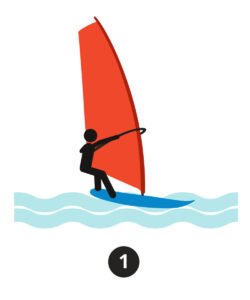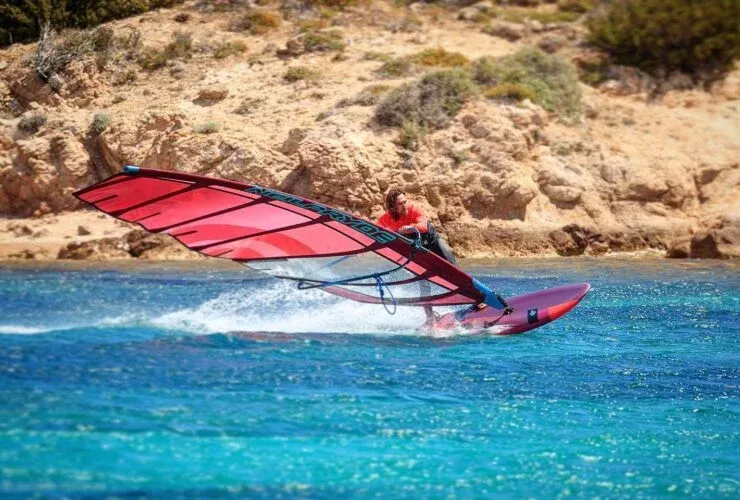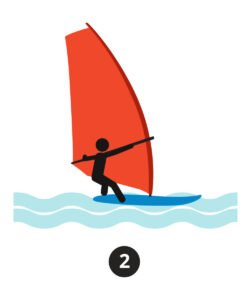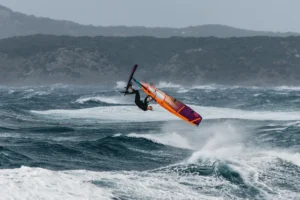The jibe is probably the most well-known subject on a windsurfing beach.
A jibe is a turn you make downwind, and it’s a skill you need to learn in windsurfing if you want to keep your hair dry! The more you improve, the better the jibe! The aim of every windsurfer is to master the jibe when planing. Once you’ve achieved that, you can challenge yourself to land it and put more style and power into it!
How do you do a jibe?
A quick jibe generally takes about 5 seconds:
1 – Preparing the jibe
2 – Entering the jibe
3 – Turning the rig over and changing feet
4 – Exit
1 – Preparing the Jibe “preparation is key”.
– Unhook and move the rear hand towards the back of the boom.
– Take the rear foot out of the strap and place it forward, between the two rear straps, and with your body “hook the boom”, ready to go into the wind with speed.

2 – Getting into the jibe “How you get into the jibe will probably determine how you get out”.
Concentrate on maintaining your speed as you enter the jibe, bend your legs (a lot!) and lean into the turn, which will allow you to shave and carve your board.
Your front foot should be in the straps, you’re probably on tiptoe pressing the top of your foot firmly into the strap to help shave the board, your back foot has moved from the centre to the opposite side and is also pushing the rail further into the water.
Lean the mast towards the nose of your board so that the sail is already forward when you get to the point where you need to tip the rig.
Look forward past your mast into the turn as you lean the rig forward.
3 – Reversing the rig and changing foot “This happens almost at the same time”.
Bring the sail forward with both hands, just before the rig change you need to slide your front hand to the boom head, then let go of the back hand and grab the sail on the other side.
Just before the rig change, you should slide your front foot towards the centre of the board and your back foot just in front of your new front foot strap. During the foot change, look away from the turn, one of the biggest mistakes is looking at your feet or what your hands are doing.
4 – Exit “get down and accelerate”.
When you receive the sail on your side, it is essential to let your weight back and lower yourself to prevent the sail from pulling you off the board. But to use the energy recreated by the sail filling with wind on your new reaching trajectory to accelerate quickly outwards. Being low and having your weight on the back foot will also allow you to quickly slide the new front foot into the strap and further increase acceleration out of the turn. Hook the rear foot back into the strap and you’re done.
Key points to remember:
– Your legs should be flexed throughout the manoeuvre, the lower you go, the more stable you will be on the board.
– Moving your hands back and forth on the boom is essential for getting the mast and rig in the right position during the manoeuvre.
Lean into the turn and tilt the mast towards the nose of your board (not backwards!).
Always look forward into and out of the turn, never your hands or feet!










